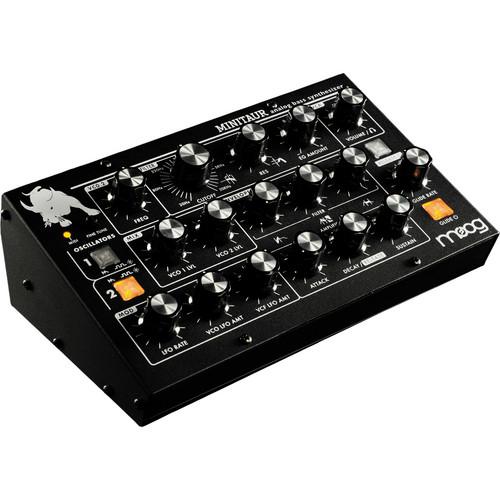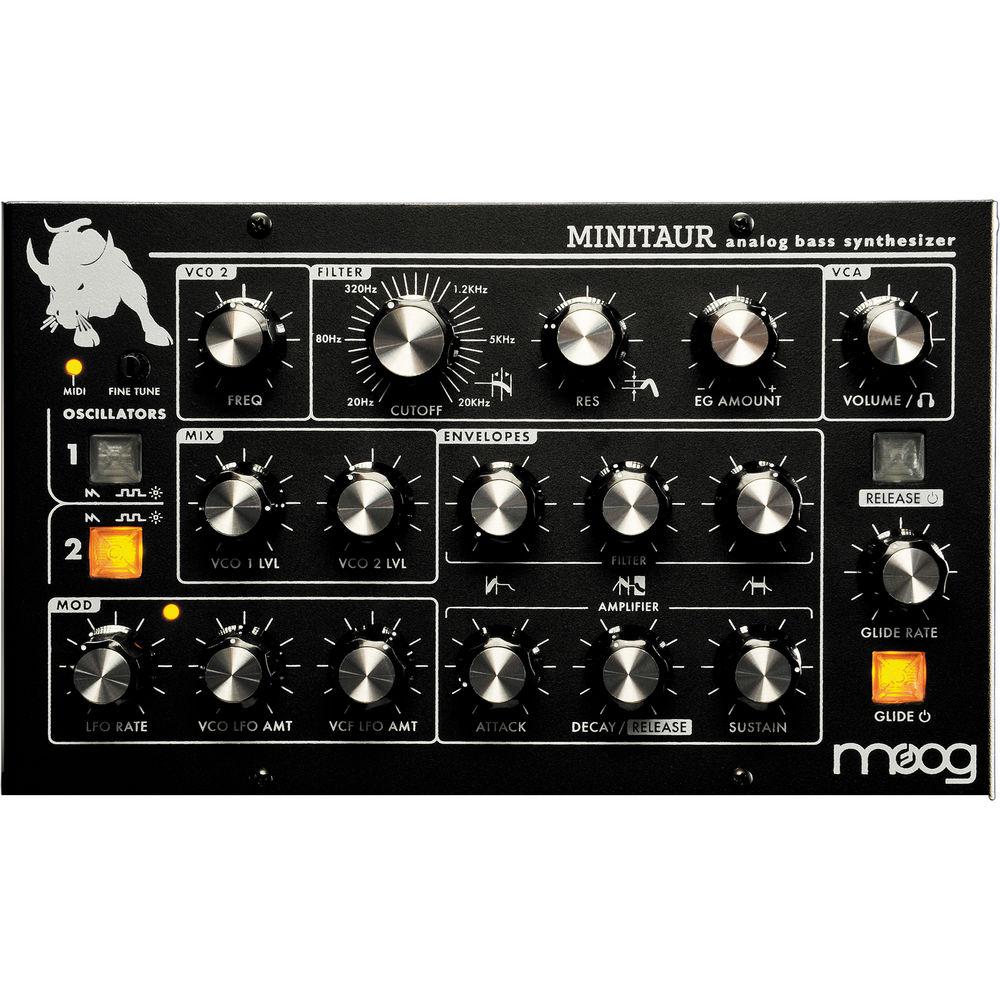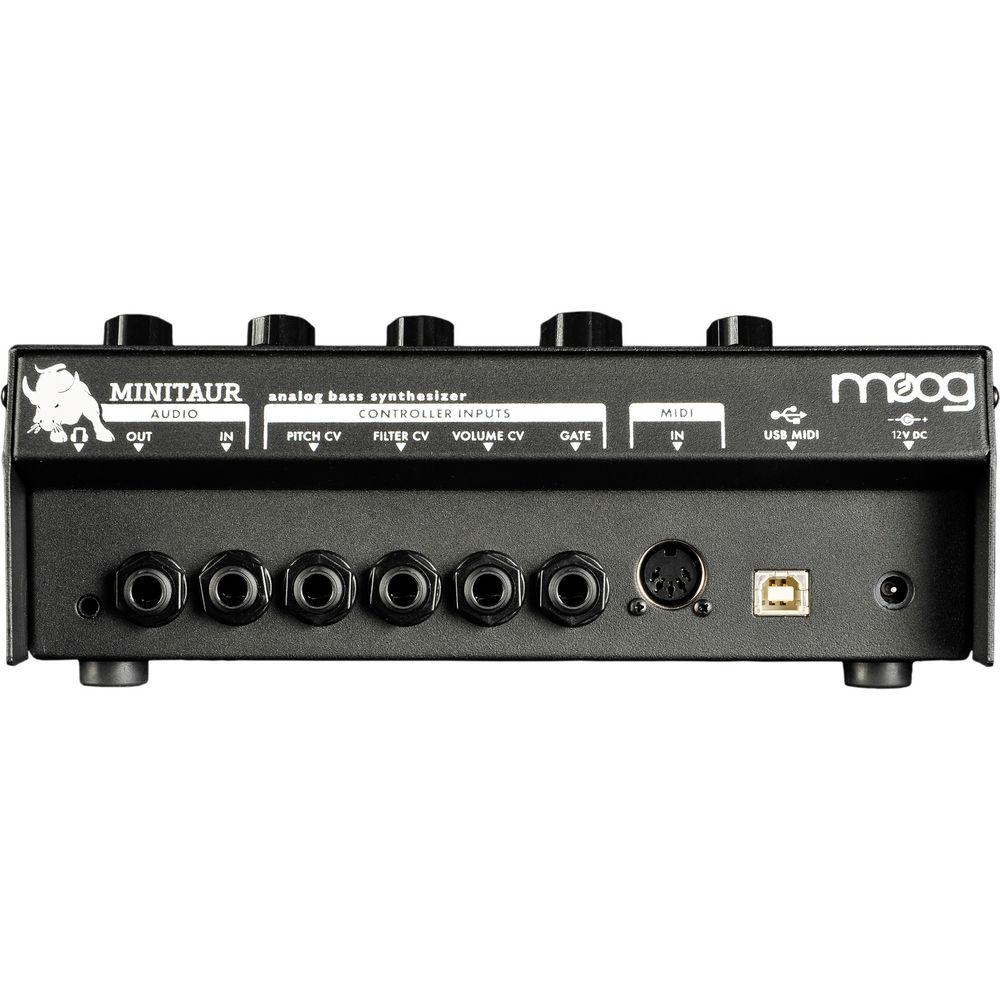|
User Manual for Moog Minitaur Analog Bass Synthesizer Click to enlarge the picture
 Contents of the user manual for the Moog Minitaur Analog Bass Synthesizer
Contents of the user manual for the Moog Minitaur Analog Bass Synthesizer
- Product category: Synthesizer Modules Moog
- Brand: Moog
- Description and content of package
- Technical information and basic settings
- Frequently asked questions – FAQ
- Troubleshooting (does not switch on, does not respond, error message, what do I do if...)
- Authorized service for Moog Synthesizer Modules

 |
User manual for the Moog Minitaur Analog Bass Synthesizer contain basic instructions
that need to be followed during installation and operation.
Before starting your appliance, the user manual should be read through carefully.
Follow all the safety instructions and warnings, and be guided by the given recommendations.
User manual is an integral part of any Moog product,
and if it is sold or transferred, they should be handed over jointly with the product.
Following the instructions for use is an essential prerequisite for protecting
health and property during use, as well as recognition of liability on the part of the manufacturer
for possible defects should you make a warranty claim. Download an official Moog user manual in which you will find instructions on how to install, use, maintain and service your product.
And do not forget – unsuitable use of a Moog product will considerably shorten its lifespan!
|
Product description The black Moog Minitaur Analog Bass Synthesizer is a programmable analog bass synthesizer designed with a one-knob-per-function design, allowing you to adjust your sounds on the fly. The Minitaur's sound engine is powered by two oscillators with selectable sawtooth or square waveshapes. With the latest firmware upgrade, v2.2 now offers up to 128 on-board presets, five additional modulation sources, hard sync, assignable CV/Gate inputs, and the ability to only modulate oscillator 2.
The synth supports MIDI via 5-pin DIN and USB MIDI, which offers control over both playing and the Minitaur's LFO, allowing it to be used to create dubstep-style wobbles and sweeps. Its rear-panel control voltage inputs provide access for additional tweaking of your pitch, filter, and volume with external CV sources. Additionally, these CV/Gate inputs can be configured via the included free editor/librarian to control any feature on or under the hood. The 1/4" mono audio input allows you to use the Minitaur's filter and envelopes on other audio sources. - New Features in v2.2
-
- Save and Recall up to 128 On-Board Presets: Select and save directly from your Minitaur’s front panel, via MIDI controller or with the free Minitaur Editor / Librarian software
- Free Editor/Librarian Software: Seamless DAW integration now with full Windows support
- Five New Modulation Sources: Tri, Sqr, Saw, Ramp, S&H and Filter EG
- Hard Sync: Access a completely new sonic palette with your Minitaur
- Modulate Oscillator 2 Only: Pair with Hard Sync for syncopated metallic sweeps and surges
- Assignable CV/Gate Inputs: Control any feature on or under the hood of your Minitaur via control voltage
- CV to MIDI Conversion: Bring control voltage into your DAW for analog control over digital circuits
- General Features
-
- Decay/Release mode allows for independent control of Decay and Release times from Minitaur's front panel
- Pitch, Volume and Gate Controller inputs can be re-mapped to other control parameters
- Minitaur can act as a CV to MIDI converter
- One-knob-per-function interface for tweaking and creating new sounds on the fly
- Two oscillators with Sawtooth (Original Taurus) and Square wave-shapes for each VCO. Recreate sounds of the original Taurus with Sawtooth waves, or create new sounds with square waves, or a combination of both
- 2 Mixer VCAs for VCO levels control of Oscillators 1 and 2
- Moog Ladder Filter with adjustable resonance delivers Taurus 1 and 3 bass and boom
- Two Minimoog-style ADSR Envelope Generators for modulating VCF and VCA. The Decay and Release segments are controlled by the Decay knob, while the Release segment is enabled or disabled via Release On/Off switch
- MIDI-syncable LFO with controls for Rate, VCO LFO Amount, and VCF LFO Amount
- 5-pin DIN MIDI and MIDI over USB offer complete control of the Minitaur's sound engine
- Analog Control inputs for Pitch, Filter, Volume and Gate. Use an EP2 or CV to connect and control Minitaur with everything from modulars to Moogerfoogers
- External audio input for processing external audio through the Mixer and Filter section of Minitaur
- Headphone output with 1/8" connection
- Steel chassis
UPC: 094922371089 In the Box Moog Minitaur Analog Bass Synthesizer (Black) 12 VDC Power Adapter Limited 1-Year Warranty Table of Contents
|
Upload User Manual
Have you got an user manual for the Moog Minitaur Analog Bass Synthesizer in electronic form? Please send it to us and help us expand our library of instruction manuals.
Thank you, too, on behalf of other users.
To upload the product manual, we first need to check and make sure you are not a robot. After that, your "Submit Link" or "Upload File" will appear.
Technical parametersMoog Minitaur Specs | Sound Engine | Analog | | Presets | 128 | | Polyphony | Monophonic (can be poly-chained) | | External Control | External Controller Response: Keyboard, pitch bend, mod wheel, after pressure, and velocity | | Oscillators | Oscillator 1:
Wave: Sawtooth/Square
Level: 0 to 100%
Oscillator 2:
Frequency: +/-12 Semitones
Wave: Sawtooth/Square
Level: 0 to 100%
Glide Rate: 0 to 100% | | Calibration Range | Oscillator Calibration Range: 22 Hz to 6.8 kHz
Note range at 8' = 18 to 116 | | Glides | Glide: Select LCR, LCT, EXP - Legato On/Off | | Filters | Moog Ladder Filter:
Cutoff: 20 Hz to 20 kHz
Resonance: 0 to Self-Oscillation
Filter Envelope Amount: -100 to 100% | | Modulation | LFO Rate with Rate LED: 0.01 to 100 Hz
Wave: Triangle
Amount to VCO: 0 to 100%
Amount to VCF: 0 to 100%
Modulation Sources: LFO (triangle, square, saw, ramp, sample & hold), filter envelope
Modulation Destinations: Oscillator pitch, oscillator 2 pitch only, filter cutoff | | Envelope Generators | 2x Envelope Generators
Attack Time: 1 ms to 30 s
Decay Time: 1 ms to 30 s
Sustain Level: 0 to 100%
Release Time: 1 ms to 30 s
Release: On/Off | | LFO | LFO Panel Features: Rate control, VCO LFO Amount, and VCF LFO Amount | | Controls | VCO 2 Frequency: Sets the frequency offset of VCO 2 from VCO 1 from -1 Octave to +1 Octave, Center is unison with VCO 1
Oscillator 1 & 2 Saw/Square Waveform Selector: Selects a Sawtooth wave (LED Off) or Square wave (LED On) Signal for VCO 1 and 2
VCO 1 Level: Sets the level of VCO 1
VCO 2 Level: Sets the level of VCO 2
VCF Cutoff: Sets the Cutoff Frequency of the 4-pole Moog Low-pass VCF from 20 Hz to 20 kHz
VCF Resonance: Sets the gain for the amount of signal from the output of the VCF fed back to the input of the VCF, This creates a peak in frequency response at the Cutoff Frequency that can be increased all the way to self-oscillation
VCF EG Amount: Bi-polar control sets the (+) or (-) amount of Envelope Generator modulation of the VCF, Center is no Envelope Generator modulation
LFO Rate: Sets the frequency of the LFO, Range is from 0.01 Hz to 100 Hz
LFO VCO Amount: Sets the amount that the LFO modulates the VCO
LFO VCF Amount: Sets the amount that the LFO modulates VCF
VCA EG Attack: Sets the attack Time of a Minimoog-style ADSR Envelope Generator used to modulate the VCA, Time ranges from 1 ms to 30 s
VCA EG Decay/Release: Sets both the decay time to the sustain level and release time of a Minimoog-style ADSR Envelope Generator used to modulate the VCA, Time ranges from 1 ms to 30 s, Release segment of the EG is enabled by Release On/Off switch
VCA EG Sustain: Sets the sustain level of a Minimoog-style ADSR Envelope Generator used to modulate the VCA
VCF EG Attack: Sets the attack time of a Minimoog-style ADSR Envelope Generator used to modulate the VCF, Time ranges from 1 ms to 30 s
VCF EG Decay/Release: Sets both the decay time to the sustain level and release time of a Minimoog-style ADSR Envelope Generator used to modulate the VCF, Time ranges from 1 ms to 30 s, The Release segment of the EG is enabled by the Release On/Off switch
VCF EG Sustain: Sets the sustain level of a Minimoog-style ADSR Envelope Generator used to modulate the VCF
Release On/Off Switch: Enables (LED On or Disables (LED Off) Release segments of both Envelope Generators
Glide On/Off Switch: Enables/ Disables the Glide function
Glide: Sets the rate of Glide when the note controlling the Minitaur changes
Volume: The Master Volume of the Minitaur's synth engine
Fine Tune: Adjusts the frequency of the VCOs +/-1 semitone
MIDI Indicator LED: Indicates incoming MIDI activity
LFO Rate Indicator LED: Indicates the rate of the LFO | | I/O | 12 VDC power inlet, accepts 12 VDC, tip positive
Monophonic Audio In: 1/4" / 6.3 mm, TS unbalanced, accepts 4 dBu line level signal
Monophonic Audio Out: 1/4" / 6.3 mm, TS unbalanced
Headphone Jack: 1/8" / 3.5 mm, TRS stereo mini-jack
Control Voltage Inputs:
Pitch CV: 1/4" / 6.3 mm TRS, 0 to 5 V
Filter CV: 1/4" / 6.3 mm TRS, 0 to 5 V
Volume CV: 1/4" / 6.3 mm TRS, 0 to 5 V
Gate: 1/4" / 6.3 mm, 5 V trigger
MIDI Input: 5-pin DIN
MIDI I/O: USB | | Conversion | CV to MIDI Conversion: Yes | | Operating System | Flash upgradeable via MIDI Sysex | | Power | 100-250 VAC, 50/60 Hz, +12 VDC | | Power Consumption | 7 W | | Dimensions (WxDxH) | 3.1 x 8.8 x 5.1" / 7.9 x 22.2 x 13.0 cm | | Weight | 2.5 lb / 1.2 kg | | | | Package Weight | 3.75 lb | | Box Dimensions (LxWxH) | 9.4 x 7.9 x 7.1" |
Rating100% users recommend this product to others. And what about you?

This product has already been rated by 29 owners. Add your rating and experience with the product.
Discussion
 Ask our technicians if you have a problem with your settings,
or if anything is unclear in the user manual you have downloaded.
You can make use of our moderated discussion.
The discussion is public and helps other users of our website who may be encountering similar problems.
Ask our technicians if you have a problem with your settings,
or if anything is unclear in the user manual you have downloaded.
You can make use of our moderated discussion.
The discussion is public and helps other users of our website who may be encountering similar problems.
The discussion is empty - enter the first post
Post a new topic / query / comment:
|
|
|
| Request for user manual |
You can’t find the operation manual you are looking for? Let us know and we will try to add the missing manual:
I’m looking for a manual / Request for manual
Current requests for instruction manuals:
NEWER F100 CAMERA MONITOR...
PhotoStage progessional...
powerpint...
Night Detective Quest 5M 5x Night Vision Monocular ...
Ibanez AM93QM User Manual....
|
| Discussion |
Latest contributions to the discussion:
TR-P5TP pink robot dog
Name: Allyson
Top Race Race & Remote Control
Hello we are having issues with the remote to the robot dog it just flashes a red light will not sync to the robot dog what so ever the dog is charged and batteries have been changed out more the once, Can i get help trouble shooting the issue or if something needs to be sent bac...
Query
Name: Libba Guyton
Canon Pixma TS9520 Wireless All-In-One Printer
Support Code 1851
Multi purpose tray guide is open. Close the guide and press OK.
Done and the same message continue to appear....
Manual
Name: Grant
Konus KonuStart-700B 60mm f 11.6 Refractor
Please send user manual for Konustart-700B to above email address....
Fs3x manual
Name: Randy Reid
DigiTech FS3X Three-Function Foot Switch
I need manual
...
adding additional chime
Name: Stan Stansfield
OhmKat Video Doorbell Power Supply for
The additional chime does not work and is closure to the transmitter then the first one. I plugged in the additional chime and set the volume and chime. The original chime works when the additional chime is plugged in to new location. The original chime is located further away bu...
|
|

